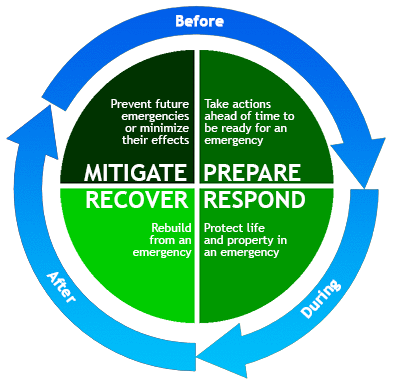Local Emergency Operations Plans’ Animal Annexes
The number of large-scale disasters, particularly related to wildfires, have raised awareness of the needs of animals in disasters and planning for meeting those needs. A comprehensive emergency management strategy could mitigate commonly occurring issues affecting animals in disasters. This strategy includes application of the principles of emergency management to the care of animals in disasters, which leads to improvements of public and animal welfare that are sustainable and will likely reduce the incidence of animal issues arising in disasters. Emergency managers recognize four phases of the emergency management lifecycle: Mitigation, Planning/Preparedness, Response, Recovery.

Planning is critical for an effective response. Judiciously developed and well implemented plans incorporate the needs of animals and their owners into the animal annexes, identify and prioritize realistic threats, hazards, and vulnerabilities, define the response mission and goals, realistically describe existing capabilities to meet the response goals, conduct capability gap analyses between actual and desired capability, and develop business plans to close any capability gaps.
New legislation, AB 580 (Rodriguez, Chapter 744, 2021), has amended Government Code SEC. 2. Section 8593.3.2 (a)(b)(4) Large animal evacuation plans. These plans shall be submitted to the Office of Emergency Services and could be reviewed to evaluate whether the plans are consistent with best practices and guidance issued by the Federal Emergency Management Agency (FEMA).
Congress passed H.R. 3858, the Pets Evacuation and Transportation Standards Act of 2006 (PETS Act), which was signed into law on October 6, 2006 by President Bush. The PETS Act amends the Robert T. Stafford Disaster Relief and Emergency Assistance Act to ensure that “State and local emergency preparedness operational plans address the needs of individuals with household pets and service animals following a major disaster or emergency”.
The California Governor’s Office of Emergency Services (Cal OES) Community Planning Unit (CPU) supports local emergency planning with an emphasis on the whole community. The unit partners with Cal OES Administrative Regions, Mutual Aid Regional Advisory Councils (MARACs), Operational Areas (OAs), and local communities. The current CPU focus is on emergency planning at the county (or operational area) level. The unit coordinates reviews of emergency operations plans to ensure that the plans incorporate best practices, protect and accommodate vulnerable populations, and establish procedures for alerting, evacuating, and sheltering individuals during an emergency. For additional information related to emergency plans and resources, visit the Cal OES CPU webpage.
The following links to County plans are provided as a resource to Operational Areas when developing/updating their animal annexes to the county emergency operations plan.
- Fresno County Operational Area Animal Evacuation and Sheltering Plan
- Los Angeles County Operational Area Emergency Operations Plan Animal Annex
- Merced County Operational Area Emergency Animal Response Annex
- Monterey County Operational Area Animal Annex D
- San Bernardino County Operational Area Emergency Animal Evacuation, Sheltering & Disaster Plan
- San Diego County Operational Area Emergency Operations Plan Animal Annex
- Sonoma County Operational Area Emergency Operations Plan Animal Annex
- Animal Care and Shelter Planning Toolkit Version 1.0, December 6, 2018
- Cal OES Emergency Plan Review Crosswalk Local Government Agencies
- County Emergency Operations Plan (EOP) Review Process Fact Sheet
- Updates to County Emergency Plan Legislation Content, Submission, and Review Fact Sheet
Local/State Resources
Animal Owner Resources
CARES Página para colorear de primeros auxilios para mascotas (Spanish)
Contact Us
CDFA Animal Health and Food Safety Services,
Animal Health Branch
Sacramento, California 95814
Phone: 916-900-5002
Fax: 916-900-5333
Email: CDFA.AHB_Cares_Program@cdfa.ca.gov



